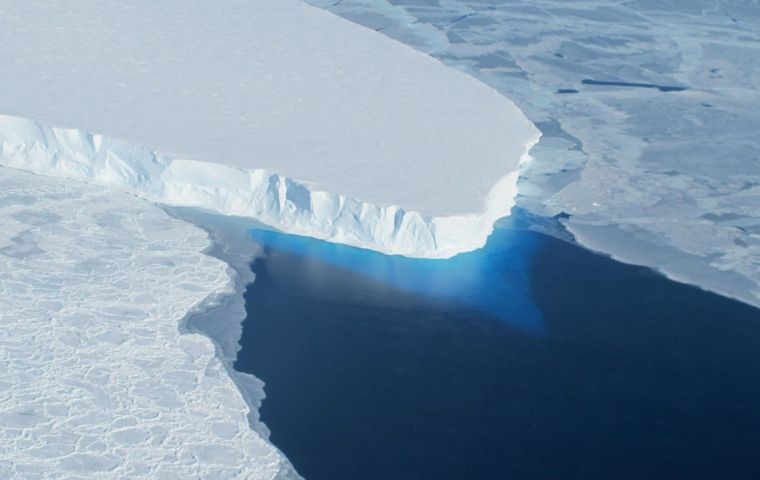MercoPress. South Atlantic News Agency
Researchers find major West Antarctic glacier melting from geothermal sources
 The collapse of the Thwaites Glacier would cause an increase of global sea level of between 1 and 2 meters
The collapse of the Thwaites Glacier would cause an increase of global sea level of between 1 and 2 meters Thwaites Glacier, the large, rapidly changing outlet of the West Antarctic Ice Sheet, is not only being eroded by the ocean, it's being melted from below by geothermal heat, researchers at the Institute for Geophysics at The University of Texas at Austin (UTIG) report in the current edition of the Proceedings of the National Academy of Sciences.
The findings significantly change the understanding of conditions beneath the West Antarctic Ice Sheet where accurate information has previously been unobtainable.
The Thwaites Glacier has been the focus of considerable attention in recent weeks as other groups of researchers found the glacier is on the way to collapse, but more data and computer modeling are needed to determine when the collapse will begin in earnest and at what rate the sea level will increase as it proceeds. The new observations by UTIG will greatly inform these ice sheet modeling efforts.
Using radar techniques to map how water flows under ice sheets, UTIG researchers were able to estimate ice melting rates and thus identify significant sources of geothermal heat under Thwaites Glacier. They found these sources are distributed over a wider area and are much hotter than previously assumed.
The geothermal heat contributed significantly to melting of the underside of the glacier, and it might be a key factor in allowing the ice sheet to slide, affecting the ice sheet's stability and its contribution to future sea level rise.
The cause of the variable distribution of heat beneath the glacier is thought to be the movement of magma and associated volcanic activity arising from the rifting of the Earth's crust beneath the West Antarctic Ice Sheet.
Knowledge of the heat distribution beneath Thwaites Glacier is crucial information that enables ice sheet modelers to more accurately predict the response of the glacier to the presence of a warming ocean.
Until now, scientists had been unable to measure the strength or location of heat flow under the glacier. Current ice sheet models have assumed that heat flow under the glacier is uniform like a pancake griddle with even heat distribution across the bottom of the ice.
The findings of lead author Dusty Schroeder and his colleagues show that the glacier sits on something more like a multi-burner stovetop with burners putting out heat at different levels at different locations.
“It's the most complex thermal environment you might imagine,” said co-author Don Blankenship, a senior research scientist at UTIG and Schroeder's Ph.D. adviser. “And then you plop the most critical dynamically unstable ice sheet on planet Earth in the middle of this thing, and then you try to model it. It's virtually impossible.”
That's why, he said, getting a handle on the distribution of geothermal heat flow under the ice sheet has been considered essential for understanding it.
Gathering knowledge about Thwaites Glacier is crucial to understanding what might happen to the West Antarctic Ice Sheet. An outlet glacier the size of Florida in the Amundsen Sea Embayment, it is up to 4,000 meters thick and is considered a key question mark in making projections of global sea level rise.
The glacier is retreating in the face of the warming ocean and is thought to be unstable because its interior lies more than two kilometers below sea level while, at the coast, the bottom of the glacier is quite shallow.
Because its interior connects to the vast portion of the West Antarctic Ice Sheet that lies deeply below sea level, the glacier is considered a gateway to the majority of West Antarctica's potential sea level contribution.
The collapse of the Thwaites Glacier would cause an increase of global sea level of between 1 and 2 meters, with the potential for more than twice that from the entire West Antarctic Ice Sheet.
The UTIG researchers had previously used ice-penetrating airborne radar sounding data to image two vast interacting subglacial water systems under Thwaites Glacier. The results from this earlier work on water systems (also published in the Proceedings of the National Academy of Sciences) formed the foundation for the new work, which used the distribution of water beneath the glacier to determine the levels and locations of heat flow.
In each case, Schroeder, who received his Ph.D. in May, used techniques he had developed to pull information out of data collected by the radar developed at UTIG.
According to his findings, the minimum average geothermal heat flow beneath Thwaites Glacier is about 100 milliwatts per square meter, with hotspots over 200 milliwatts per square meter. For comparison, the average heat flow of the Earth's continents is less than 65 milliwatts per square meter.
The presence of water and heat present researchers with significant challenges.
“The combination of variable sub-glacial geothermal heat flow and the interacting subglacial water system could threaten the stability of Thwaites Glacier in ways that we never before imagined,” Schroeder said.




Top Comments
Disclaimer & comment rules-

-

-

Read all commentslts not Geo-thermal heat melting the glacier from the bottom.
Jun 12th, 2014 - 09:47 am 0lts the heat from Nazi nuclear reactors of New Schwabia that have gone critical.
Run for your lives!
@1
Jun 12th, 2014 - 11:04 am 0Plus all the breath of CFK when she makes those ever longer speeches.
You can't switch off the rise of geothermal magma and vulcanism
Jun 12th, 2014 - 11:10 am 0by curtailing fossil fuels and recycling fridges.
Yup, it looks like a 1 - 2 metre sea level rise.
Better start re-locating coastal cities soon!
Commenting for this story is now closed.
If you have a Facebook account, become a fan and comment on our Facebook Page!